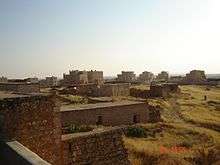Elbeğendi

Elbeğendi (Syriac: ܟܦܪܐ ܬܚܬܝܬܐ Kafro Tahtayto) is an Assyrian/Syriac village in Midyat District of Mardin Province (Tur Abdin), Turkey. It has a population of 50 people, all of which followers of the Syriac Orthodox Church. The village was abandoned during the 1990s due to the PKK conflicts and rising tension in the region, but was recently repopulated.
Thanks to the return of some stability, many of the refugees are returning, with wealth gained overseas. Many of the Syriacs that left managed to successfully immigrate to European countries such as Germany and Sweden because of their precarious situation(applying as political refugees), and therefore gain the advantage of much higher pay and education standards relative to what most other people in the region have. Their comparative wealth has allowed them to have enough money on a basis of purchasing power to build spectacular mansions, buy land, renovate abandoned properties, and to invest in the region.[1]
Entomology
The Syriac name for the village, Kafro Tahtayto, means lower village. Kafro is the Aramaic word for village. To distinguish it from a nearby village of the same name, the two places with Tahtayto (sub) and Helayto (top) were designated. Therefore, this village was named Kafro Tahayto.[2] The upper Village is located approximately 26 km further north.
Geography
The village is located 15 kilometers southeast of Midyat. It lies on a slight hill and is located about 900 m above sea level. The border with Syria is 20 km from Elbeğendi. There is a high incidence of white limestone as well, which is one of the main building components here.
Climate
The seasons are very pronounced with many rainfall in spring and autumn, hot and dry summers and cold and snowy winters. The temperatures vary between -10 °C in winter and +25 °C in summer. The soil is very fertile from volcanic lava deposited in it.
History
According to oral tradition, the village Kafro Tahtayto has its origins even before the birth of Christ. In the Assyrian Genocide, the entire population of the village fled to the Mor Malke Monastery and Mor Elijah Monastery in Ehwo, so it temporarily stood empty. Afterwards the population slowly came back. The area was fully populated and things were peaceful until the 1980s, when the fighting between Kurds and the Turkish military broke out southeastern Turkey. Due to the war many residents migrated to Western Europe, where most continue to reside. In the early 2000s several Assyrians came back to the region with money earned in Europe, with which they used to build large houses or renovate their old ones.
Demographics
- 1900: 30 families
- 1915: 20 families
- 1916: 8 families
- 1970: 46 families
- 1992: 5 families
- 1995: 0 The last three families left the village Kafro
About 180 families from the original village of Kafro Tahtayto live spread across Germany, Sweden and Switzerland. In the summer of 2006 many families returned to the area. Today 15 families live in a newly built settlement in Kafro.
Elbeğendi consists of 46 houses, which are traditionally two-storey. In the traditional houses, The family lived on the upper floor, while the ground floor served as stables. Each property is fenced in by a wall where crops are grown. The town also has a schoolhouse which was built in 1964. The water supply consists of 80 self-built deep wells. The newer houses are typically 2-3 stories. The houses are built with lavish stonework on large plots and modern amenities on plots of land with trees and stone walls. The newer houses are also much larger than the older ones, in some cases 3x the size.
The old portion of the village is in very poor condition due to years of abandonment. Several houses have collapsed, and others are in poor condition. The churches are in ruins as well, with their interiors destroyed. However, When the area was repopulated in the early 2000s after the conflict in the region died down, the Assyrians rebuilt a new town next to the old one. The new village has houses with European standards- paved roads, electricity, plumbing, solar energy, etc.
Religion
The area around Kafro Tahtayto was, like all of Tur Abdin, Christianized in the first centuries after Christ. The villagers are members of the Syriac Orthodox Church. Some of the churches in the village and are include-
- Church Mor Yahkup built in the 5th century
- Church Mor Barsaumo built in the 5th century
- Memorial House Virgin Mary
- Church Mor Bosuss
- Memorial House Kadisto
Economy
The inhabitants of Elbegendi have lived throughout history on agriculture. Even now the people here farm, although now most of them only do it for their own consumption, not having a need to sell their products. Some of the fruits grown here include figs, pomegranates, apples, melons, and watermelons. vegetables and grains grown here include wheat, barley, cucumber, and almonds. On the surrounding hills wine is also grown, whose grapes are also processed into raisins.
References
- ↑ http://america.aljazeera.com/articles/2015/5/24/syriac-village-turkey-finds-voice.html
- ↑ http://www.kafro.com/kafro.html
Coordinates: 37°16′57″N 41°24′25″E / 37.28250°N 41.40694°E